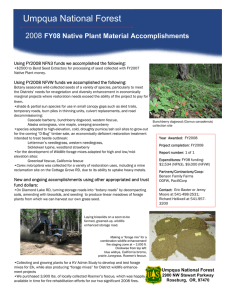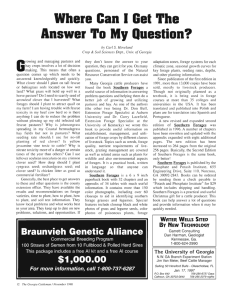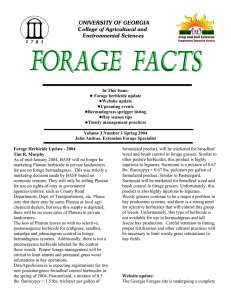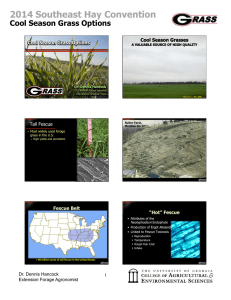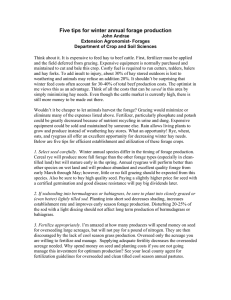Decreasing winter hay needs using stockpiled forages
advertisement
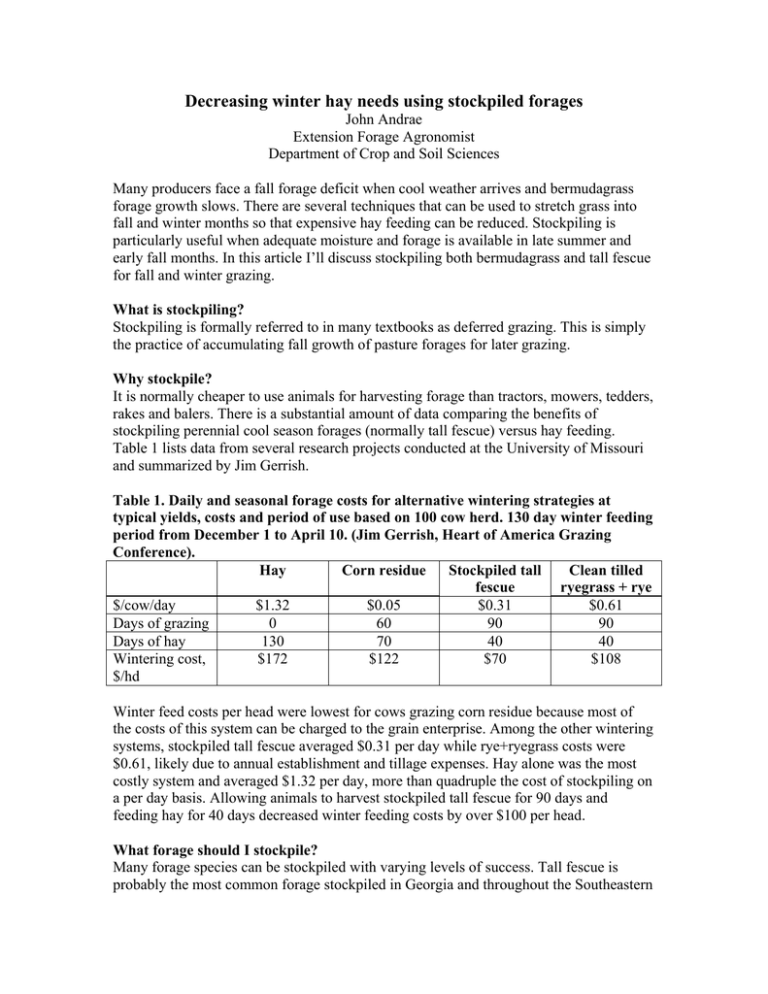
Decreasing winter hay needs using stockpiled forages John Andrae Extension Forage Agronomist Department of Crop and Soil Sciences Many producers face a fall forage deficit when cool weather arrives and bermudagrass forage growth slows. There are several techniques that can be used to stretch grass into fall and winter months so that expensive hay feeding can be reduced. Stockpiling is particularly useful when adequate moisture and forage is available in late summer and early fall months. In this article I’ll discuss stockpiling both bermudagrass and tall fescue for fall and winter grazing. What is stockpiling? Stockpiling is formally referred to in many textbooks as deferred grazing. This is simply the practice of accumulating fall growth of pasture forages for later grazing. Why stockpile? It is normally cheaper to use animals for harvesting forage than tractors, mowers, tedders, rakes and balers. There is a substantial amount of data comparing the benefits of stockpiling perennial cool season forages (normally tall fescue) versus hay feeding. Table 1 lists data from several research projects conducted at the University of Missouri and summarized by Jim Gerrish. Table 1. Daily and seasonal forage costs for alternative wintering strategies at typical yields, costs and period of use based on 100 cow herd. 130 day winter feeding period from December 1 to April 10. (Jim Gerrish, Heart of America Grazing Conference). Hay Corn residue Stockpiled tall Clean tilled fescue ryegrass + rye $/cow/day $1.32 $0.05 $0.31 $0.61 Days of grazing 0 60 90 90 Days of hay 130 70 40 40 Wintering cost, $172 $122 $70 $108 $/hd Winter feed costs per head were lowest for cows grazing corn residue because most of the costs of this system can be charged to the grain enterprise. Among the other wintering systems, stockpiled tall fescue averaged $0.31 per day while rye+ryegrass costs were $0.61, likely due to annual establishment and tillage expenses. Hay alone was the most costly system and averaged $1.32 per day, more than quadruple the cost of stockpiling on a per day basis. Allowing animals to harvest stockpiled tall fescue for 90 days and feeding hay for 40 days decreased winter feeding costs by over $100 per head. What forage should I stockpile? Many forage species can be stockpiled with varying levels of success. Tall fescue is probably the most common forage stockpiled in Georgia and throughout the Southeastern US. Tall fescue has excellent weathering characteristics and nutrient content remains adequate for beef cows well into winter months and eliminates the need for supplementation. In extreme north Georgia, orchardgrass can also be stockpiled, but because tall fescue has higher fall forage production and lower weathering losses, tall fescue is a better choice. Warm season forages can be stockpiled but are more susceptible to weathering losses following frost. Bermudagrass is commonly stockpiled in eastern Texas and Oklahoma and has the potential to be utilized for dormant fall grazing in Georgia; however, potential problems with this practice will be discussed below. Managing tall fescue for stockpiling. Remove low quality seedheads and summer growth by clipping or grazing closely in mid August to early September. This will allow regrowth of vegetative high quality forage. After grazing off residue, remove cattle and apply fertilizer to provide good fall growth. Fall forage production depends upon nitrogen rate and timing as well as on moisture and temperature. If fertilizer is applied in the early fall, nitrogen use is fairly efficient with 20 to 40 pounds of forage produced per pound of nitrogen. Most states recommend nitrogen application rates ranging from 40 to 80 pounds per acre depending on weather conditions and application timing. If the wet summer conditions that we’ve experienced in North Georgia continue and fertilizer is applied in early September, a high rate of nitrogen (6080 pounds) would be justified. Later nitrogen applications will result in lower forage production. If nitrogen is applied in late September or early October rates should probably be reduced. Production and quality of stockpiled tall fescue. A commonly used rule of thumb is that one strip grazed acre of 12” tall fescue will support a beef cow for 70 to 90 days. Fall accumulated tall fescue has excellent nutrient content. One reason for this high quality is that tall fescue remains vegetative in fall months and contains no low quality stems or seedheads. Another reason for the high quality of stockpiled tall fescue is shown in table 2. Sugar content and digestibility of tall fescue in autumn months are elevated and exceed nutrient requirements of beef cattle. Unfortunately, the detrimental toxins present in toxic endophyte-infected tall fescue are still present in fall and negatively impact animal performance. Table 2. Effect of season on sugar, crude protein and dry matter digestibility of tall fescue. From Buckner, 1975. Univ. of KY Bulletin AGR-44. Spring Summer Fall Sugars, % 9.5 8.5 19 Crude Protein, % 22 18 19 Dry Matter Digestibility, % 69 66 74 In addition to its high initial forage quality, fall stockpiled tall fescue has excellent resistance to weathering. Tall fescue maintains high nutrient content under repeated freeze-thaw cycles. Even though stockpiled tall fescue can look brown and weathered in late winter, remember that looks can be deceiving. Often this ragged and brown tall fescue can have crude protein values that exceed 10% and TDN that exceeds 60%. These values surpass the average bermudagrass hay baled in Georgia. Managing bermudagrass for stockpiling. While bermudagrass is frequently stockpiled in eastern Oklahoma and Texas, research data from the Southeastern US is limited and conflicting. Studies conducted in the 1970s near Tifton Georgia examined the feeding value of “weathered” or stockpiled warm season grasses (a mixture of bermudagrass, dallisgrass and bahiagrass) for brood cows. In these studies, stockpiling began either in mid-August or mid-September. Continuous grazing of stockpiled bermudagrass began in mid-November after 8-12 weeks of regrowth. The first killing frost occurred on December 3rd in this study. The mature stockpiled forage was low in quality (about 6% crude protein) which is not surprising since the forage was three months old. Animal gains were generally positive for the first two weeks after grazing began, but declined rapidly following frost and weathering. Recent data from Darrell Rankins in Alabama indicates more positive animal responses when grazing stockpiled bermudagrass. In this study conducted at Sand Mountain, a Tifton 44 field was harvested for hay in early August of both 2001 and 2002. Nitrogen was applied following harvest and the field accumulated approximately two tons of dry bermudagrass forage by mid-October. This 8.7 acre field was strip grazed both years with 24 dry gestating beef cows from mid-October to mid-December. A frontal polywire fence was moved twice weekly to limit cattle access to stockpiled forage and improve forage utilization. A protein supplement was provided both years. Dry cows maintained their initial body condition while grazing the stockpiled bermudagrass in both years indicating that it may be possible to effectively utilize stockpiled bermudagrass with proper management and supplementation in the Southeastern US. Please remember that these were dry cows with low nutrient requirements. Future research is planned to examine stockpiled warm season forages in both Alabama and Georgia. How should stockpiled forages be grazed? Consider the effects of weathering and prioritize pastures for grazing. Graze forages that are most susceptible to weathering losses first. The quality of warm season forages will decline rapidly after frost. These species should be utilized first. After bermudagrass or has been utilized, stockpiled orchardgrass and tall fescue should be grazed. Control cattle grazing. Stockpiled forage utilization is substantially decreased when grazing is not controlled in some manner. Unlimited access to large areas of stockpiled forages will result in substantial losses to trampling. Utilize strip grazing to control animal access to the forage. An inexpensive and effective method of limiting access is to use a solar charger, polywire and step posts to allocate about two to three days worth of forage at a time. Begin grazing near the water source and simply move the fence forward as needed to prevent excess forage trampling. No backfence is needed. Allocating a three day feed strip of stockpiled tall fescue increased grazing days by 40% in Missouri and decreased feed costs by 30% when compared to a 14 day feed strip allocation. Using this simple technique is worth the small time and equipment investment. Summary Stockpiled forages offer an economical alternative to late fall and early winter hay feeding. Allowing the cow to harvest stockpiled tall fescue will decrease winter hay needs while maintaining cow condition. Begin stockpiling now for good yields of cost effective high quality tall fescue. Further improve harvest efficiency and stretch forage supply by strip grazing. Grazing stockpiled bermudagrass with appropriate supplementation may also offer an acceptable fall forage option, but more research in the Southeast is needed in this area.
